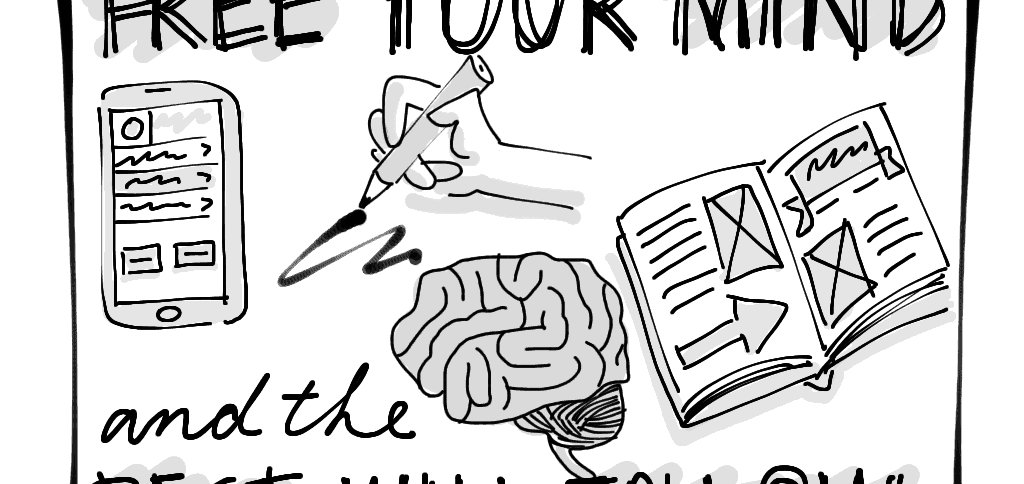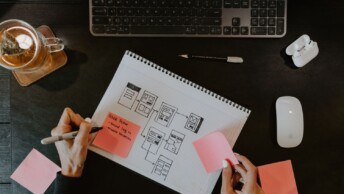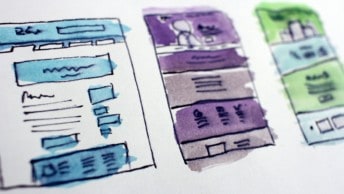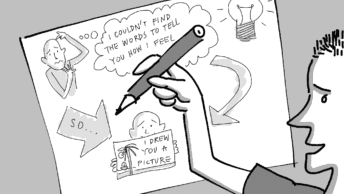Over the course of my career I’ve been fortunate to be able to explore other roles beyond the hazy boundaries of “user experience design”: project management, illustration, strategy, whiteboard animation, and internet marketing, among others. My UX skills have served me well in all of these roles, but there are two roles for which I’ve found UX skills to be particularly useful: graphic recording and graphic facilitation.
Which skills, specifically? Well, the 5 indispensable skills for UX mastery, according to UIE’s intrepid researcher, Jared Spool: sketching, facilitating, presenting, storytelling, and critiquing. Graphic recording and graphic facilitation play right into the domain of UX designers because they explicitly combine the first two skills on this list.
What is graphic recording?
Graphic recording is like sketchnoting—visual note-taking—only on a large scale. Professional graphic recorders are often employed at conferences to capture panel discussions and presentations. It can be fascinating to watch a map of the conversation come to life, and the end result serves as a rich record of the highlights of the event.
Graphic recording may also be performed on a document camera, and projected onto a large surface; while this approach does not deliver the advantage of having a large poster that you can hang on your wall afterwards, it makes it easier to record the creation of the sketch, and speed it up to turn into a whiteboard animation afterwards.
Different graphic recorders will have different styles, but the premise of combing imagery with text, and using size, colour and weight to add structure are the fundamentals for transforming an audio narrative into a visual record. Does it help if you can draw well? Of course—if you can do so quickly. However, one’s drawing ability is in fact not the most critical skill to have—being a good listener, and being able to synthesise what you’re listening to, pull out important concepts, capture them quickly while buffering the next part of the conversation are skills that are even more crucial. A beautiful, intricately illustrated visual summary that omits key information is much less useful than a concise map that summarises concepts using simple text and iconic images—something that is at the heart of visual thinking.
What is graphic facilitation?
Graphic facilitation is like graphic recording, with one primary difference: graphic facilitators do more than just capture a conversation—their output informs the conversation. Because the conversation is recorded live, with all of the synthesis and structure we mentioned earlier, conversations flow better. Points that have been raised and captured are not revisited. Participants feel validated and are more engaged, enthused and eager to participate.
A graphic facilitator may interact with the meeting participants to clarify details or request more information. The session may, if appropriate, even become collaborative, with participants picking up markers themselves to contribute to the canvas. If you have any experience in running participatory design sessions, then graphic facilitation may be something that comes naturally to you!
Think beyond the wireframes
For some, the fields of graphic recording and graphic facilitation may feel like an enormous leap out of your comfort zone. However, if you’re serious about advancing your career as a UX designer, hopefully you’ve already begun work on improving your visual thinking skills and trying to instil a whiteboard culture into your place of work. These roles, whether you choose to pursue them with rigour or you just wear one of these hats for the day, are guaranteed to make your meetings more interesting, your team more engaged, and your job more interesting.
And it’s hard to argue with that.
Resources for learning more
Books
- The Graphic Facilitator’s Handbook by Brandy Agerbeck
- The Doodle Revolution by Sunni Brown
- The Sketchnote Handbook by Mike Rohde
Courses
- The Sketchnote Handbook by Mike Rohde
- Visual Note-taking 101 by Sunni Brown
- Become a Rockstart Scribe by AlphaChimp University






Awesome discussion Matt on the value that this adds to any UX designer’s skill set. The one thing that I hear alot from those starting out with this is that they simply “can’t” draw. Synthesizing and breaking down complex concepts is at the heart of it all. Thanks for sharing.
Duke
Thanks Matt!
I am really keen to expand my capabilities in graphic recording and facilitation.
A couple of Aussie resources I would recommend for training, books, blog, examples, etc.:
– Lynne Cazaly (Melbourne): http://www.lynnecazaly.com.au
– Michelle Walker at Curious Minds Co.: http://www.curiousmindsco.com.au (online course available from April 2014)